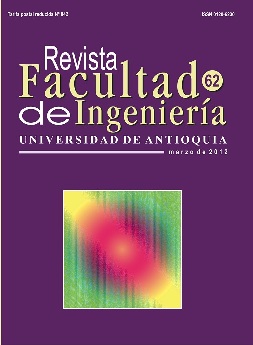Hydrochemical background of the Salar de Aguas Calientes I (Chile)
DOI:
https://doi.org/10.17533/udea.redin.12463Keywords:
Aguas Calientes I, evaporites, andean salar, hydrothermal activity, hydrochemistryAbstract
The salar “Aguas Calientes I” is a saline system located in the Chilean altiplane at 4.280 m.a.s.l, and exposed to arid climatic conditions. Chemistry of waters exposed in the salar surface has been studied in this work. During the field survey, several sectors with surficial waters were accurately located by means of GPS, and solutions in springs, wetlands, and saline ponds were sampled. Samples were adequately stored and carried to laboratory for chemical analysis. In several places, saline solid material was also collected for mineralogical analysis.
The main water inputs to the salar are situated in the northern and southern areas, this latter being thermal. Other inputs are the scarce precipitations that enter into the salar as surficial and/or subsurficial runoff. All these waters circulate towards the lowest areas of salar, being accu-mulated in several ponds along the western edge as consequence of a light tilting of salar surface.
The water chemistry indicate that all of them belong to the same chemical type, Na-Cl, despite the high dispersion in solute content. This is due to the interaction between solutions and underground saline deposits of salar, mainly composed of halite and gypsum. Moreover, concentrations of Li, B, and As were high for all samples, typical of waters related to hydrothermal activity. In the case of As all samples show concentrations above toxicity level, even in the most diluted. The non-thermal fresh spring waters outcropping in the northern margin flow towards the salar, feeding along their course an important wetland (locally named bofedal) and supplying fresh water to herds of camelids. On the contrary, waters present in central and southern areas of salar are highly concentrated in ponds without plants in their margins. Ponds are rimmed by saline minerals, whose mineralogical analysis together with physicochemical calculations on water chemical data indicate an active process of mineral precipitation involving halite and gypsum.
Downloads
References
F. Risacher, H. Alonso, C. Salazar. “Salar de Aguas Calientes 1”. Geoquímica de aguas en cuencas cerradas: I, II y III Regiones. Convenio de Cooperación dga – ucn – ird-, S.I.T. Nº51. Enero, Santiago de Chile. 1999. pp: II - 99 [AC1] - II - 110 [AC1].
Dirección General de Aguas (DGA). Balance Hídrico de Chile: Ministerio de Obras Públicas, Transporte y Telecomunicaciones. Gobierno de Chile. 1987. pp. 24.
B. Mason, D. Pyle, C. Oppenheimer. “The size and frequency of the largest explosive eruptions on Earth”. Bulletin of Volcanology. Vol. 66. 2004. pp. 735-748. DOI: https://doi.org/10.1007/s00445-004-0355-9
J. Lindsay, S. de Silva, R. Trumbull, R. Emmermann, K. Wemmer. “La Pacana caldera, N. Chile: a reevaluation of the stratigraphy and volcanology of one of the world’s largest resurgent calderas”. Journal of Volcanology and Geothermal Researc. Vol. 106. 2001. pp. 145-173. DOI: https://doi.org/10.1016/S0377-0273(00)00270-5
R. Alonso. “On the origin of La Puna borates”. Acta Geológica Hispánic. Vol. 34. 1999. pp.141-166.
L. Plummer, D. Parkhurst, G. Fleming, S. Dunkle. Computer program incorporating Pitzer’s equations for calculation of geochemical reactions in brines: US Geological Survey. Water-Resources Investigation Report. WRI 88-4153. 1988. pp. 310.
K. Pitzer. “Thermodynamics of electrolytes. I. Theoretical basis and general equations”. Journal of Physical Chemistry. Vol. 77. 1973. pp. 268-277. DOI: https://doi.org/10.1021/j100621a026
C. Harvie, N. Moller, J.Weare. “The prediction of mineral solubilities in natural waters: The Na-KMg-Ca-H-Cl-SO4 -OH-HCO3 -CO3 -CO2 -H2 O system to high ionic strengths at 25 ºC”. Geochimica et Cosmochimica Acta. Vol. 48. 1984. pp. 723-751. DOI: https://doi.org/10.1016/0016-7037(84)90098-X
P. López, L. Auqué, I. Garcés y G. Chong. “Características geoquímicas y pautas de evolución de las salmueras superficiales del Salar de Llamará, Chile”. Revista Geológica de Chile. Vol. 26. 1999. pp. 89-108. DOI: https://doi.org/10.4067/S0716-02081999000100005
H. Eugster, L. Hardie. Saline Lakes. Lakes, Chemistry, Geology, Physics. A. Lerman (editor.). Ed. Springer Verlag. New York (USA). 1978. pp. 237-293. DOI: https://doi.org/10.1007/978-1-4757-1152-3_8
Downloads
Published
How to Cite
Issue
Section
License
Copyright (c) 2018 Revista Facultad de Ingeniería

This work is licensed under a Creative Commons Attribution-NonCommercial-ShareAlike 4.0 International License.
Revista Facultad de Ingeniería, Universidad de Antioquia is licensed under the Creative Commons Attribution BY-NC-SA 4.0 license. https://creativecommons.org/licenses/by-nc-sa/4.0/deed.en
You are free to:
Share — copy and redistribute the material in any medium or format
Adapt — remix, transform, and build upon the material
Under the following terms:
Attribution — You must give appropriate credit, provide a link to the license, and indicate if changes were made. You may do so in any reasonable manner, but not in any way that suggests the licensor endorses you or your use.
NonCommercial — You may not use the material for commercial purposes.
ShareAlike — If you remix, transform, or build upon the material, you must distribute your contributions under the same license as the original.
The material published in the journal can be distributed, copied and exhibited by third parties if the respective credits are given to the journal. No commercial benefit can be obtained and derivative works must be under the same license terms as the original work.










 Twitter
Twitter